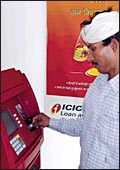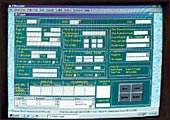 |
 |
| As banks sense the potential
of the market, they are adopting specially designed technological
tools for their customers. Citibank India's biometric
ATMs are an example |
As
Indian Microfinance Institutions (MFIs) begin scaling up their
reach and complying with new reporting and disclosure norms, they
are beginning to realise that they will need to become far more
information technology-friendly. "Microfinance entities may
be NGOs and their loan sizes may be small, but what they are essentially
doing is banking, which requires very robust systems," says
Manish Khera, CEO, FINO (Financial Information Network & Operations),
an ICICI Bank-promoted technology provider to MFIs. "You
can't do banking without backend engine and security of data and
audit systems, even though most MFIs require less complex products."
Instead of developing its own solutions,
FINO has been sourcing products from established vendors. It has
picked i-Flex's Flexcube as its backend engine (channel interface,
product engines and data repository) and roped in IBM as its service
provider. At the customer end, FINO employs chip-based biometric
cards that are specially designed for rural micro-borrowers. The
cards enable capturing of data and identification of a customer
through fingerprint, which help MFIs meet the know-your-customer
(KYC) requirements. "You don't require an online system because
you can go to rural woman's home and validate her identity by
swiping the card on a mobile device," says Khera. fino has
sold about 1,000 such cards to KAS Foundation, an Orissa-based
MFI, and is in the process of selling 130,000 cards to other MFIs.
 Not
everyone thinks a monopoly like FINO is a good idea, but everyone
agrees that it can play a crucial role in ensuring transparency
and cutting transaction costs, given that consumers are geographically
widely spread. Says Vijay Mahajan, Founder-chairman of BASIX,
an MFI that describes itself as a livelihood promotion institution:
"The hard part is not product innovation, but distribution
and it is here that MFIs can offer the real innovation."
Adds Vishnu R. Dusad, Managing Director, Nucleus Software, a New
Delhi-based software vendor: "In fact, technology's potential
to cut costs goes beyond microfinance in rural areas. In the years
to come, better it systems will allow cost effective universal
banking, adding three billion borrowers to the worldwide retail
credit market." Not
everyone thinks a monopoly like FINO is a good idea, but everyone
agrees that it can play a crucial role in ensuring transparency
and cutting transaction costs, given that consumers are geographically
widely spread. Says Vijay Mahajan, Founder-chairman of BASIX,
an MFI that describes itself as a livelihood promotion institution:
"The hard part is not product innovation, but distribution
and it is here that MFIs can offer the real innovation."
Adds Vishnu R. Dusad, Managing Director, Nucleus Software, a New
Delhi-based software vendor: "In fact, technology's potential
to cut costs goes beyond microfinance in rural areas. In the years
to come, better it systems will allow cost effective universal
banking, adding three billion borrowers to the worldwide retail
credit market."
As banks sense the potential of the market,
they are adopting specially designed technological tools for their
microfinance customers. Citibank India recently launched a biometric
ATM for its microfinance customers. "Biometric ATMs have
multiple language capabilities as also a voice-enabled navigation
facility, simple screens and colour-coded buttons. Using these
ATMs, customers can conveniently access their account and carry
out routine banking transactions like balance enquiry, deposits
and withdrawals with ease," says P.S. Jayakumar, Country
Business Manager, Global Consumer Group, Citibank India.
The biometric ATMs, designed for 'Citibank
Pragati' savings account holders, can be conveniently located
at offices of Citibank's partner MFIs and in areas that are located
close to where the customers live and work. Citibank Pragati is
a no-frills savings account facility for microfinance customers
that Citibank offers directly and in partnership with MFIs. However,
ICICI Bank was the first to launch such ATMs.
Technology apart, the industry will need
pooled resources. ICICI Bank's Nachiket Mor, for example, says
that to serve a market of more than 400 million unserved Indians,
the industry will need shared technology platforms, which could
also act as a data repository for a credit bureau. The challenge,
however, would be in creating back offices that various MFIs could
share without duplicating resources. SKS's Vikram Akula feels
much would depend on the ability to do "a Coke-like standardisation,
factory-style training, as with McDonald's, and lean processes
of a Toyota".
SKS has developed its own it systems and
uses smart cards at its centres (called Sangam) that can be used
by less educated employees, since workers at its rural centres
tend to be school graduates-a staple for most MFIs.
Pradan's 'Computer Munshi'
 |
| NGO Pradan employs computer-literate
munshis. The industry, however, needs to pool
resources to serve such a huge market |
Unique situations demand unique solutions.
Or, at least, that's what Mahajan-founded Delhi-based NGO, Pradan,
believes in. The NGO, whose stated objective is to help rural
poor and marginal farmers develop sustainable livelihoods, assists
self-help groups (SHGs) in seven states. Since Pradan likes its
SHGs to stand on their own feet within two years, it employs an
innovative system of bookkeeping called the Computer Munshi System.
The workings of the system have been described in detail by Ajit
Kanitkar and Jan Meissner in their research paper "The Computer
Munshi System of Pradan"; the latter works for Germany's
development agency GTZ and the former is with the Ford Foundation.
The system, the researchers say, is built around two key personnel:
A group accountant (GA) and a computer-literate munshi or an accounting
clerk, both of whom are paid a nominal fee by the group members
for their services. Apparently, it is possible for a computer
munshi to serve up to 300 groups. There are some problems with
the system (like the munshi not being able to understand the GA's
handwritten notes) but those are not significant enough to derail
the system.
As MFIs and SHGs come up with more such innovations,
the microfinance landscape will sport more of technology. Nucleus'
Dusad, for instance, says that his company's vision is to take
cost cutting to the next level. "We want to make software
that will slash the transaction costs of the banks and make it
possible for them to lend as small amounts as Rs 100," he
says. If that happens, micro loans could become vastly cheaper.
|







 Not
everyone thinks a monopoly like FINO is a good idea, but everyone
agrees that it can play a crucial role in ensuring transparency
and cutting transaction costs, given that consumers are geographically
widely spread. Says Vijay Mahajan, Founder-chairman of BASIX,
an MFI that describes itself as a livelihood promotion institution:
"The hard part is not product innovation, but distribution
and it is here that MFIs can offer the real innovation."
Adds Vishnu R. Dusad, Managing Director, Nucleus Software, a New
Delhi-based software vendor: "In fact, technology's potential
to cut costs goes beyond microfinance in rural areas. In the years
to come, better it systems will allow cost effective universal
banking, adding three billion borrowers to the worldwide retail
credit market."
Not
everyone thinks a monopoly like FINO is a good idea, but everyone
agrees that it can play a crucial role in ensuring transparency
and cutting transaction costs, given that consumers are geographically
widely spread. Says Vijay Mahajan, Founder-chairman of BASIX,
an MFI that describes itself as a livelihood promotion institution:
"The hard part is not product innovation, but distribution
and it is here that MFIs can offer the real innovation."
Adds Vishnu R. Dusad, Managing Director, Nucleus Software, a New
Delhi-based software vendor: "In fact, technology's potential
to cut costs goes beyond microfinance in rural areas. In the years
to come, better it systems will allow cost effective universal
banking, adding three billion borrowers to the worldwide retail
credit market."